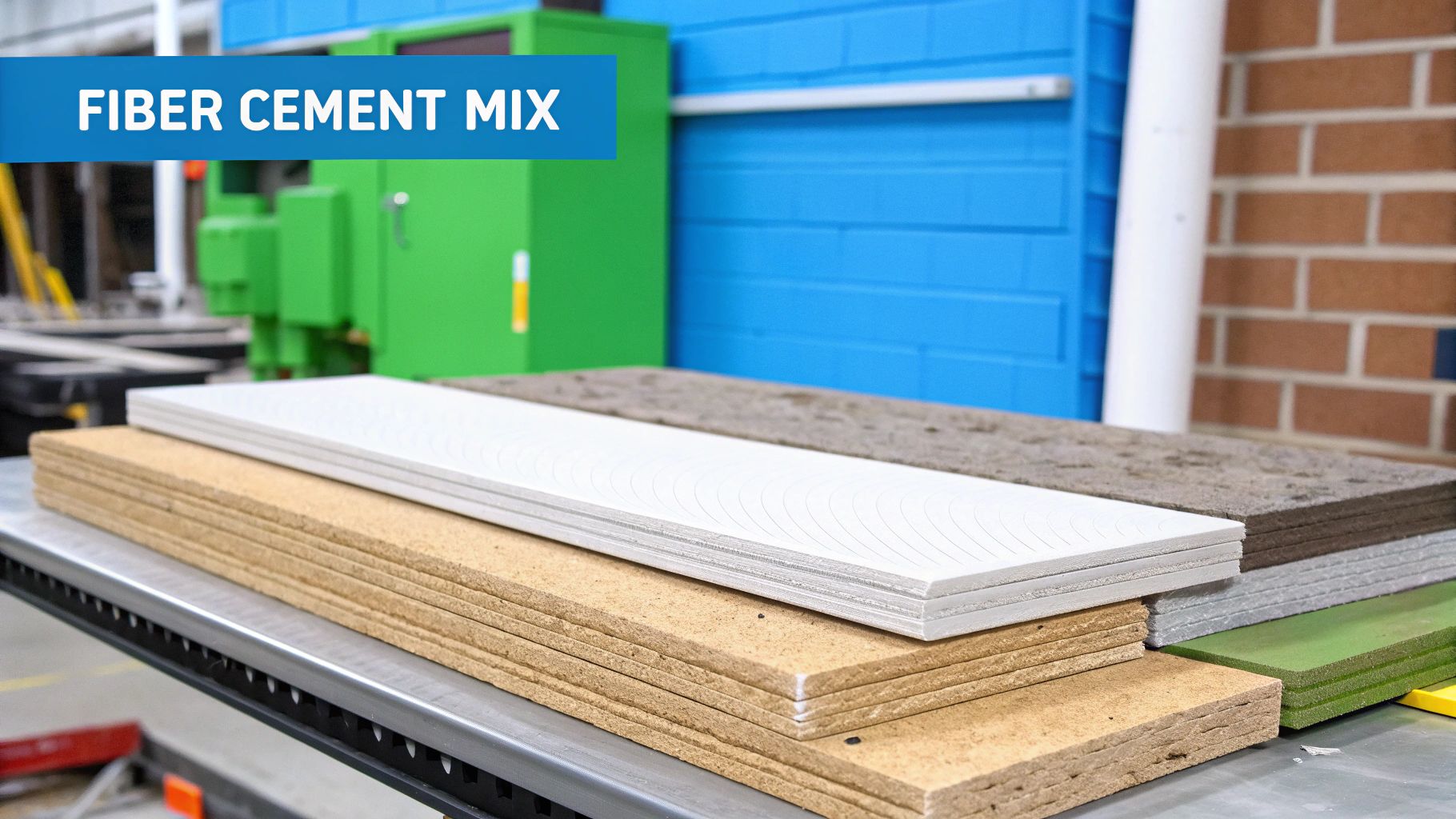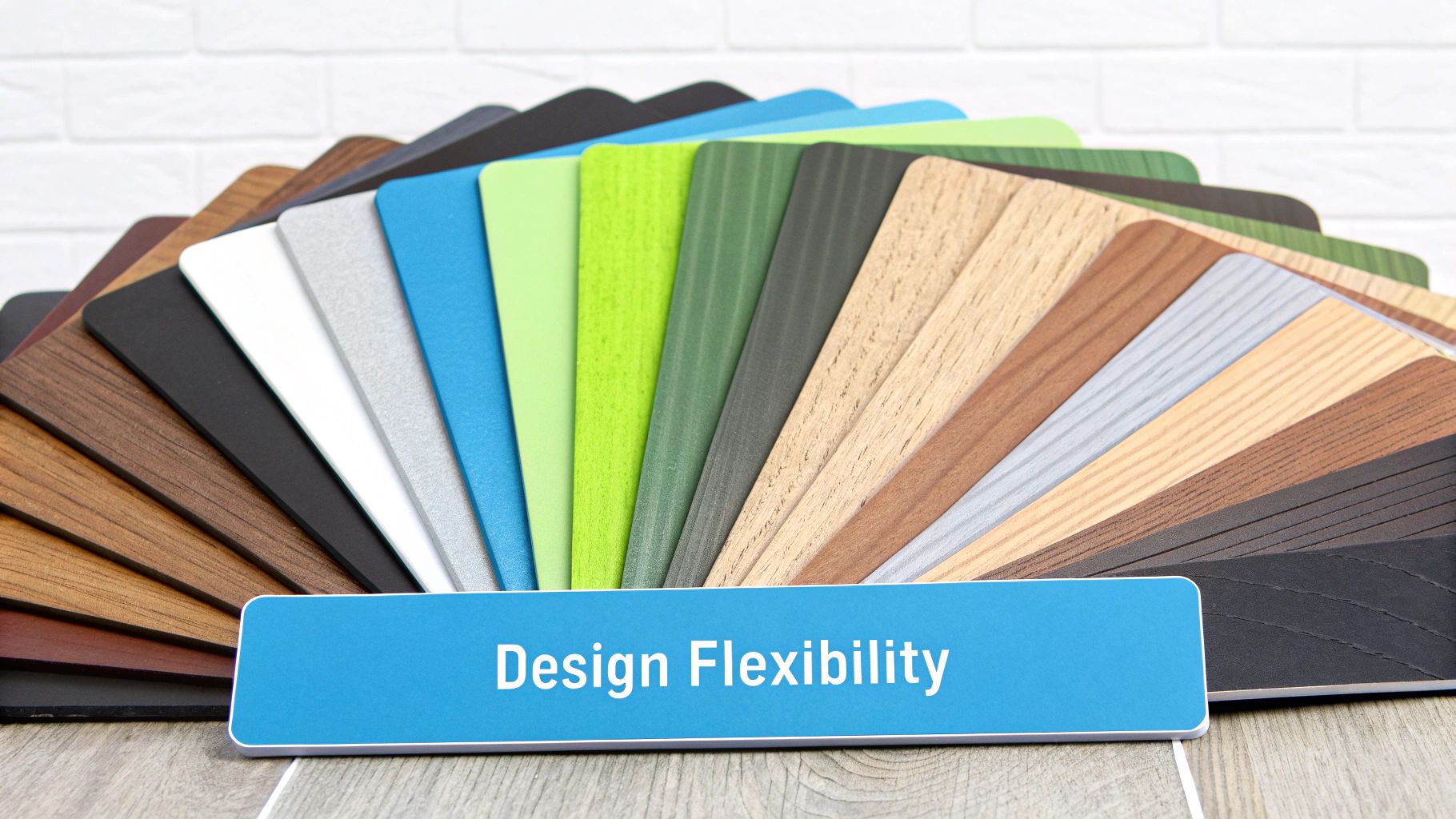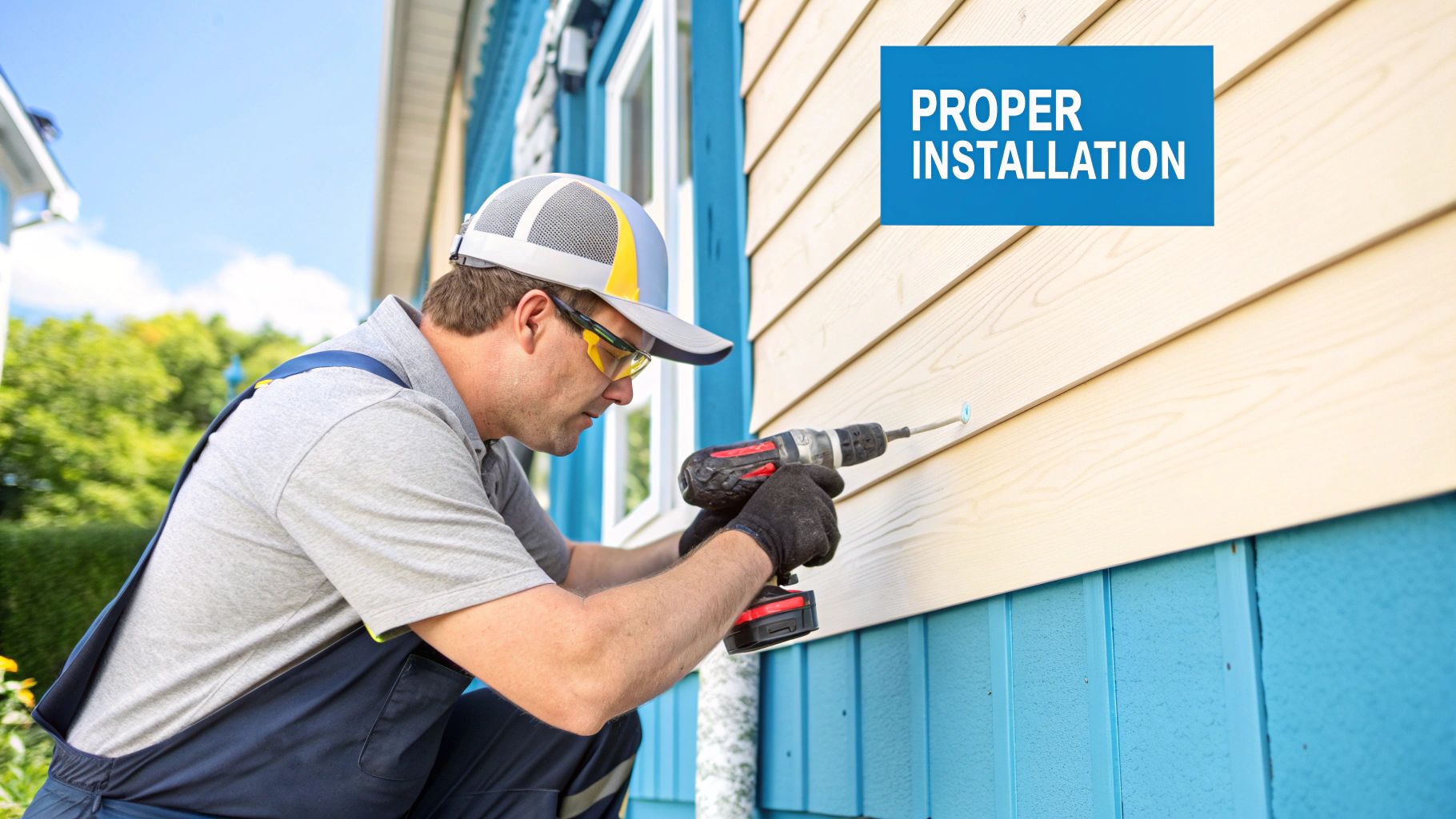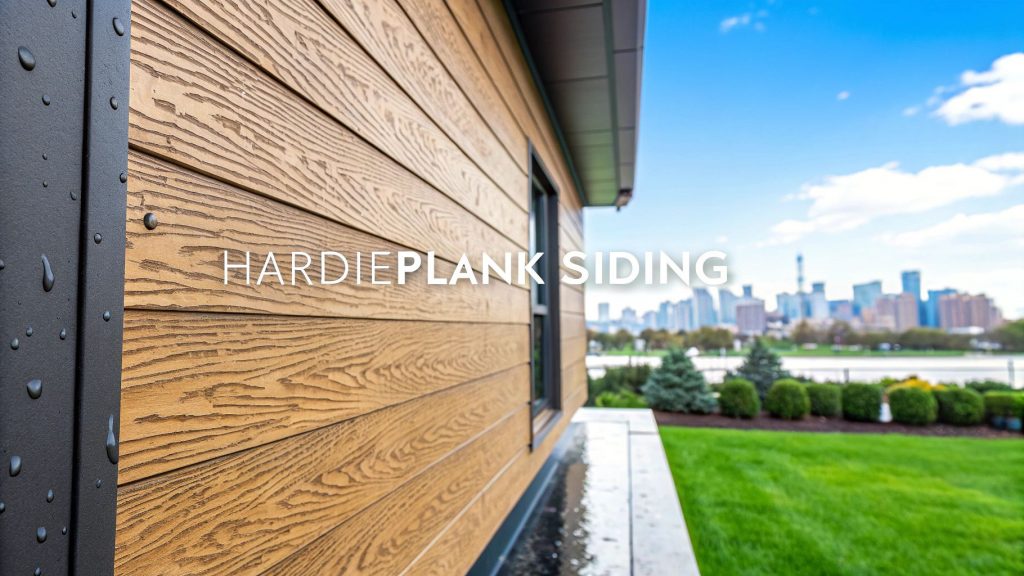When people talk about siding replacement, the name HardiePlank almost always comes up, and for good reason. It’s the brand name for a specific type of fiber cement siding, a super-tough composite material that acts like armor for your home. This isn’t your grandfather’s wood siding; it's a meticulously engineered blend of cement, sand, water, and cellulose fibers, all combined to create something incredibly resilient.
What Is HardiePlank Siding Actually Made Of?

Here in the Seattle area, when homeowners ask what HardiePlank is, what they’re really asking is, "Can it handle our weather?" The answer is a resounding yes, and it all comes down to its unique recipe. Think of it less like a simple building material and more like a high-tech formula for protecting your home from the Pacific Northwest's damp climate.
First introduced to the U.S. market back in the early 1990s, this product changed the game for exterior cladding. It offered the classic look of wood without the headaches of rot, pests, and constant repainting, quickly becoming a favorite for both builders and homeowners. You can learn more about its origins and how it evolved.
The Core Components
So, what’s in the secret sauce? The brilliance of HardiePlank is how it uses four simple, powerful ingredients that work together perfectly.
- Portland Cement: This is the muscle. It provides the core strength and durability, making the siding resistant to everything from hail to stray baseballs.
- Sand: Finely ground sand acts as a stabilizer. It helps the planks stand up to weathering, which is crucial for resisting the constant moisture we get around here.
- Cellulose Fibers: These are a game-changer. Sourced from wood pulp, these fibers are woven into the mix to add flexibility, preventing the siding from becoming brittle and cracking over time.
- Water: Water is what brings it all together. It activates the cement, binding the ingredients into an incredibly dense and solid board.
To put it simply, here is a quick overview of what defines HardiePlank.
HardiePlank Siding at a Glance
| Attribute | Description |
|---|---|
| Material Type | Fiber Cement |
| Key Ingredients | Portland Cement, Sand, Cellulose Fibers, Water |
| Primary Benefit | Exceptional durability and resistance to moisture, rot, and pests |
| Appearance | Can mimic the look of wood, stucco, or stone |
| Maintenance | Low; requires periodic cleaning and repainting (less frequently than wood) |
This simple yet effective formula is what makes the final product so special.
In essence, HardiePlank combines the brute strength of concrete with the flexible, workable nature of wood. The result is a material that thrives in conditions where others would warp, rot, or fall apart.
For any homeowner in the Puget Sound region, this specific engineering means you get a siding replacement that not only looks great but also provides genuine peace of mind, year after year, rain or shine.
What Exactly Is HardiePlank Siding Made Of?
Ever wondered what gives HardiePlank siding its legendary toughness? It’s not one single thing, but a specific recipe where each ingredient plays a key role. Think of it less like a simple mixture and more like baking a really durable cake—the final product is way stronger than any of the raw ingredients on their own.
The core of its strength comes from Portland cement, giving the siding its foundational muscle and ability to resist impacts. To that, they add finely ground sand, which is the secret to its stability. Here in the Puget Sound, where temperatures can swing wildly, this prevents the siding from expanding and contracting, a common cause of warping and buckling in other materials.
The final ingredient is cellulose fibers, which come from wood pulp. These fibers act like a hidden reinforcement, much like rebar inside concrete, providing just enough flexibility to keep the siding from becoming brittle and cracking under pressure.
A Recipe for Resilience
This carefully balanced mix creates a siding that’s dense and non-porous, making it an ideal barrier against the things that give Seattle homeowners headaches. First developed back in the early 1980s, this blend of materials created a siding that was not only tough but also cut down on long-term maintenance costs. You can learn more about the history of this durable siding to see how it evolved.
What you end up with is a shield for your home that naturally stands up to:
- Moisture Saturation: It doesn't soak up our constant rain like wood, which means no rot or decay.
- Pest Infestations: Termites and carpenter ants can’t chew through it, unlike wood siding.
- Fire: The material itself won't burn or add fuel to a fire, which is a huge safety advantage.
By designing a material that specifically tackles the challenges of our wet, ever-changing climate, HardiePlank siding isn't just a cosmetic choice. It's a genuine, long-term defense for your home's structure. That smart science is what makes it such a solid investment.
Why HardiePlank Is Perfect for the PNW Climate
Seattle's weather is no joke. The persistent damp and drizzle we're famous for can be absolutely brutal on a home's exterior, which is why understanding what is HardiePlank gives local homeowners a serious advantage.
Think of traditional wood siding like a sponge. It soaks up all that moisture, which leads to swelling, warping, and eventually, rot. From a builder's perspective, that's a recipe for long-term problems. HardiePlank, on the other hand, is made of fiber cement, a material that simply doesn't absorb water. It stays put, which means no buckling, no softening, and no welcoming mat for the mold and mildew that love our Puget Sound climate.
Built for Our Freeze-Thaw Cycles
Another major challenge here is the constant freeze-thaw cycle we see in the colder months. Water seeps into the tiny cracks and pores of most siding materials, then freezes and expands, literally tearing the siding apart from the inside out. It's a slow but destructive process.
HardiePlank was engineered to handle exactly these kinds of punishing temperature swings without cracking or delaminating. This inherent toughness is a huge reason for its long lifespan in our region. Add to that the James Hardie ColorPlus® Technology—a factory-baked finish that's cured in multiple layers. This process creates a vibrant, tough-as-nails coating that resists fading from both our endless rain and the surprisingly intense UV rays we get in the summer.
This infographic really puts the performance differences into perspective, especially for our climate.

The numbers don't lie. HardiePlank is built to stand up to the very elements that cause other materials to fail around here.
To see how these materials stack up head-to-head against Seattle's specific weather challenges, take a look at this quick comparison.
HardiePlank vs Common Siding in Seattle
| Feature | HardiePlank | Wood Siding | Vinyl Siding |
|---|---|---|---|
| Moisture Resistance | Excellent. Does not absorb water, preventing rot and mold. | Poor. Absorbs water, leading to swelling, warping, and decay. | Good. Repels water but can trap moisture behind panels. |
| Pest Resistance | Excellent. Not an organic food source for termites or woodpeckers. | Poor. Susceptible to termites, carpenter ants, and woodpeckers. | Good. Pests can't eat it, but they can nest behind it. |
| Freeze-Thaw Durability | Excellent. Engineered to withstand expansion/contraction cycles. | Poor. Prone to cracking and splitting as absorbed water freezes. | Fair. Can become brittle in the cold and crack upon impact. |
| Fire Resistance | Excellent. Non-combustible material. | Poor. Highly flammable unless treated with chemicals. | Poor. Melts and can release toxic fumes when exposed to fire. |
This table highlights why so many local contractors and homeowners are making the switch. HardiePlank simply checks all the boxes for a durable, low-maintenance exterior in the Pacific Northwest.
A successful siding replacement is more than just the material; it’s a complete system. Professional installation with the right water-resistive barriers and flashing techniques creates a weather-tight envelope that protects your home's structure.
Ultimately, choosing HardiePlank for a Seattle home isn't just an aesthetic upgrade. It’s a smart, long-term investment in a material specifically designed to win the battle against our unique climate, giving you peace of mind for decades to come.
Exploring HardiePlank Styles and Designs

When people think about ultra-durable siding, they often picture something bulky and plain. That couldn't be further from the truth with HardiePlank. The beauty of this material is that you don't have to trade toughness for style.
Whether you're restoring a historic Queen Anne in Seattle or building a sleek modern home in Bellevue, there’s a Hardie product to match. The secret is knowing how to use the different tools in the James Hardie toolbox. HardiePlank Lap Siding gives you that timeless horizontal look everyone recognizes, but that's just the starting point.
As pros, we often mix textures and profiles to add depth and character. This ensures a siding replacement doesn't just protect your home, but truly honors its original architectural charm.
Matching Siding to Your Home's Architecture
Every home has its own personality, and the right siding can make it shine. Fortunately, the James Hardie line offers incredible flexibility to get the look just right.
- HardiePanel Vertical Siding: Looking for a crisp, contemporary aesthetic? Vertical panels create clean, sharp lines perfect for a modern design. We often pair them with trim boards to create that classic board-and-batten style you see on updated farmhouses.
- HardieShingle Siding: This is the go-to for capturing the iconic feel of a Pacific Northwest Craftsman or a cozy cottage. It gives you the beautiful, textured look of cedar shakes without all the maintenance headaches.
- HardieTrim Boards: Think of these as the picture frame for your siding. They wrap around windows, doors, and corners, giving the entire project a polished, high-end finish that pulls the whole design together.
The real design magic happens when you start combining these elements. A classic technique is to use lap siding for the main body of a house and then add shingle accents in the gables. It's a simple way to create instant visual interest and boost curb appeal.
Pre-Primed vs. ColorPlus Technology
The final piece of the puzzle is the finish. You have two main paths you can take here.
First, you can get the boards pre-primed and ready for paint. This gives you complete freedom to pick any custom color under the sun and have it painted on-site.
The other option is James Hardie’s ColorPlus® Technology. This is a factory-applied, baked-on finish that’s incredibly resistant to fading and chipping. It even comes with a 15-year warranty on the finish itself. Take a look at this home finished with ColorPlus technology to see how clean and uniform it looks.
Ultimately, the choice comes down to a simple trade-off: unlimited custom color versus a super low-maintenance, long-lasting finish straight from the factory.
Understanding the HardiePlank Installation Process

The incredible performance of HardiePlank siding really boils down to one critical factor: a flawless installation. While materials like vinyl or wood can be more forgiving, fiber cement is a different beast altogether. It's a heavy, specialized product that absolutely demands precision from a professional crew.
This isn't your typical weekend DIY project. Getting it right requires specific tools, in-depth training, and a deep understanding of how to create a weather-tight shield for your home. From start to finish, the process is a craft that ensures your investment pays off for decades to come.
Key Stages of a Professional Installation
A proper install isn't just about nailing boards to a wall; it's about making every plank work as part of a complete system. Certified installers are trained to focus on a few key areas that make all the difference, especially when standing up to the Pacific Northwest climate.
- Precise Cutting: Cutting fiber cement creates fine silica dust. Professionals use special saws with dust collection systems or shears to get clean edges while keeping the job site safe.
- Correct Fastening: This is huge. Installers must use specific corrosion-resistant fasteners and place them perfectly. This secures the siding but still allows for the natural, subtle expansion and contraction that all materials go through with temperature shifts.
- Meticulous Gap Management: The spacing at joints, corners, and around trim has to be exact. These gaps are then sealed according to James Hardie’s best practices to lock out any chance of water getting behind the siding.
A common shortcut we see is "face nailing"—driving nails right through the visible front of the board instead of "blind-nailing" them at the top where the next board hides them. This doesn't just look sloppy; it can compromise the weather barrier and even void the product’s warranty.
The company behind this material, James Hardie, has a legacy built on innovation. Since pioneering asbestos-free fiber cement back in the 1980s, they've become a global leader by obsessing over quality and performance. You can discover more insights about James Hardie's history on mcclellandsroofing.com to see just how the brand has evolved over the years.
Common Questions About HardiePlank Siding
https://www.youtube.com/embed/GHwnJH_n4q4
Deciding to re-side your home is a huge step, and it's only natural to have a lot of questions. We get it. To help you feel confident about your decision, we've put together answers to the most common questions we hear from Seattle homeowners about HardiePlank.
Here are the straightforward, no-fluff answers you’re looking for.
How Much Does HardiePlank Cost Compared to Other Options?
Let's be upfront: HardiePlank is a premium siding, and its initial price reflects that quality. You'll find it's generally more of an investment than standard vinyl but often more budget-friendly than top-tier clear cedar.
But the real story is in the long-term value. Think about the total cost of ownership over the decades. Thanks to its incredible durability and minimal upkeep, HardiePlank delivers a much better return on your investment. You save a significant amount over time because you're not constantly paying for repairs, repainting, or a full replacement that other materials need much sooner.
What Kind of Maintenance Does HardiePlank Require?
This is where HardiePlank really pulls ahead of the pack—it's famously low-maintenance. For the most part, all it needs is a gentle wash-down with a garden hose and a soft brush every 6 to 12 months. This is just to rinse off the surface dirt and grime that naturally builds up in our damp Seattle climate.
You’ll never have to worry about the rot or pest damage that plagues wood siding. And if you opt for their ColorPlus® Technology, the factory-baked finish is warrantied for 15 years against peeling, chipping, and cracking. That means you can put away the paint scraper and forget about repainting for a very, very long time.
For many homeowners in the Pacific Northwest, the freedom from constant painting and repairs is one of the most significant benefits. It’s a siding solution designed to look great for years without demanding your constant attention.
How Long Does HardiePlank Siding Actually Last?
When installed correctly by a certified team, HardiePlank siding is built to last for 50 years or even longer. That's not just a guess; it's a testament to its engineering.
James Hardie backs this up with a 30-year, non-prorated, and transferable warranty—one of the absolute best in the siding industry. Its proven resistance to moisture, fire, pests, and impact means it will protect and beautify your home for a lifetime. It’s truly one of the most reliable investments you can make in your property.
Ready to see if HardiePlank is the right fit for your Seattle-area home? The expert team at Breeze Siding is here to answer all your questions and provide a free, no-obligation estimate for your siding replacement project. Contact us today to get started.

